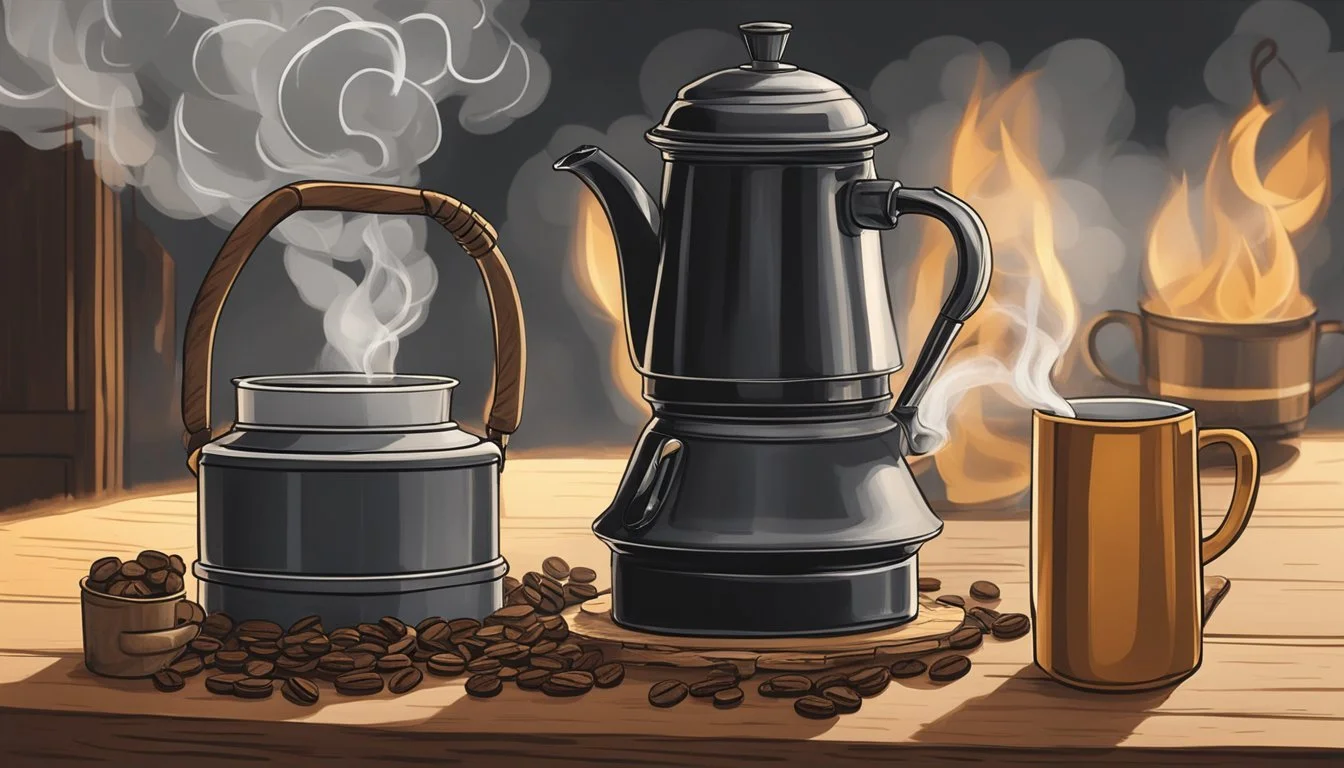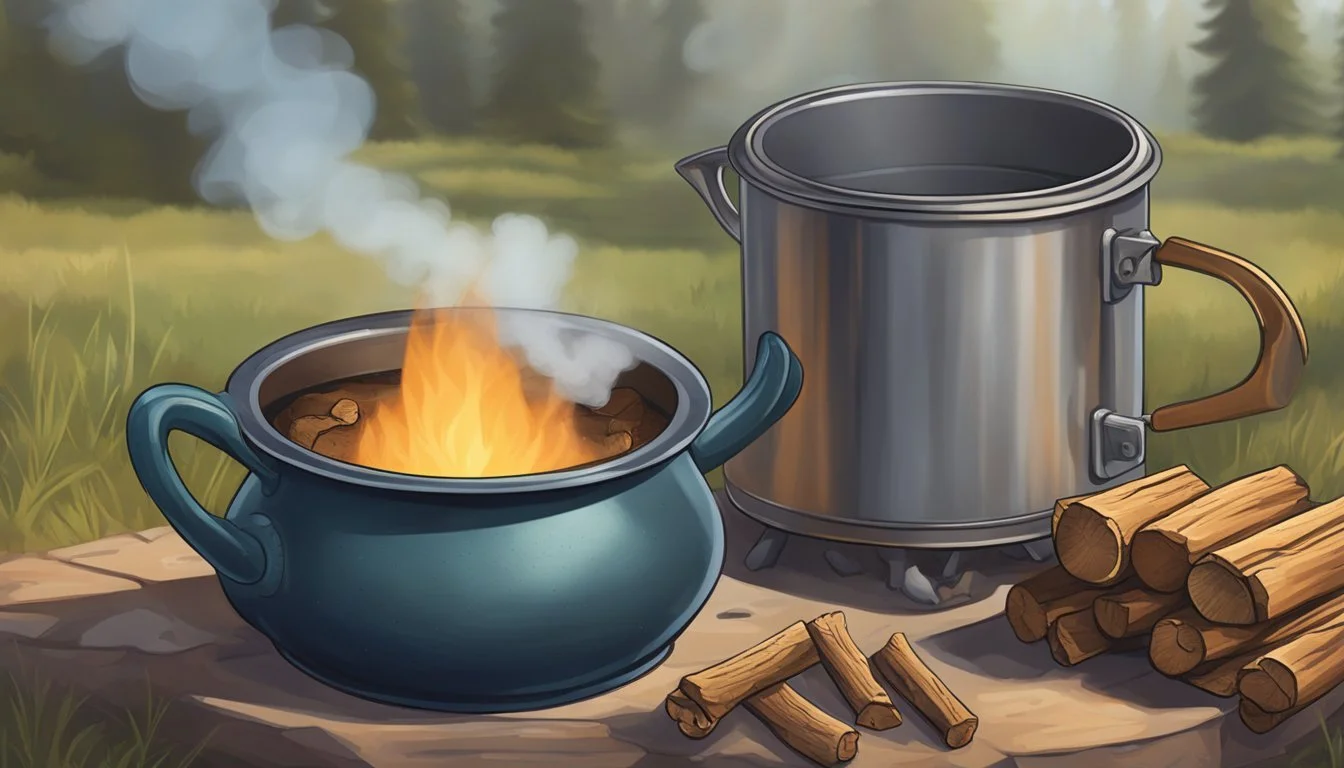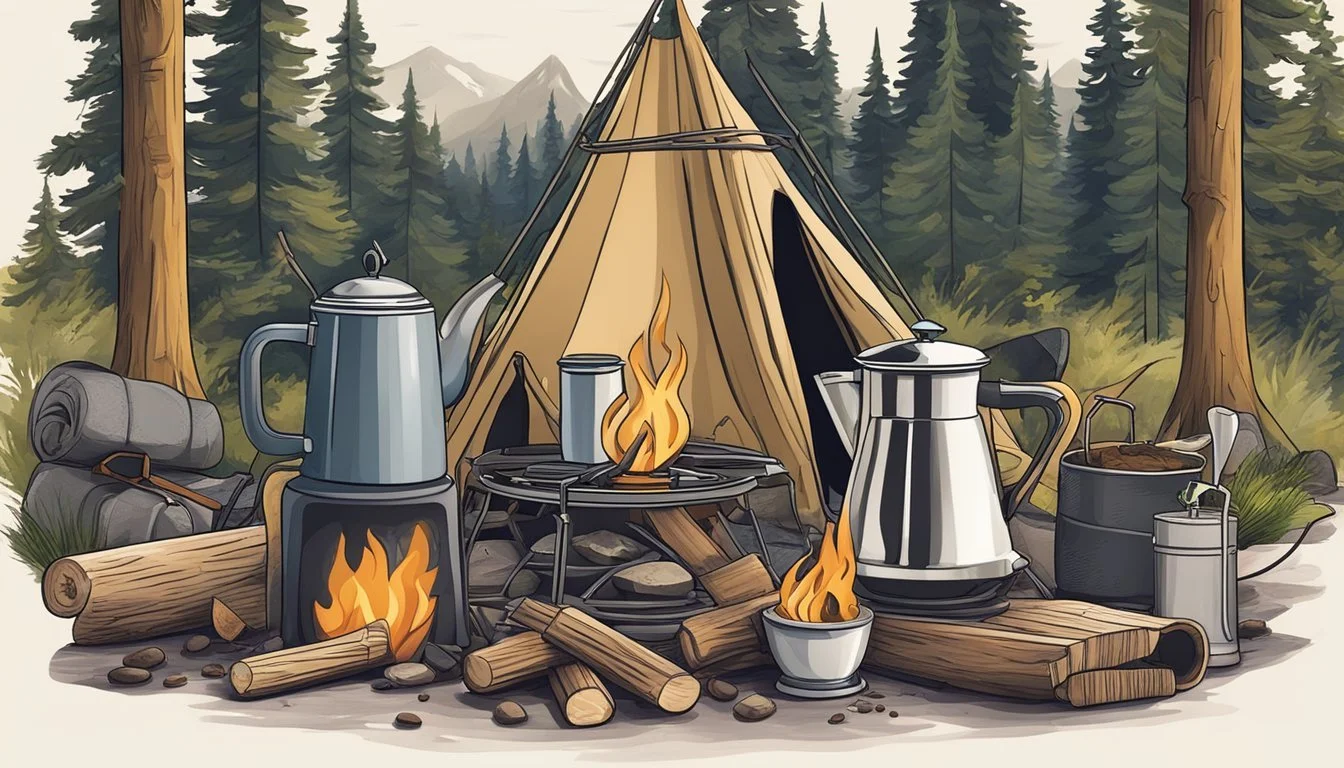The Secret to Perfect Cowboy Coffee Over a Campfire
Mastering the Art of Rustic Brewing
Cowboy coffee, a brew steeped in the rugged tradition of the American frontier, is an iconic symbol of the old Wild West. It's a simple, yet artful way of making coffee that catered to the lifestyle of cowboys who moved from one campsite to the next. The simplicity of cowboy coffee lies in its minimalistic approach, requiring only ground coffee, water, and a heat source, commonly a campfire. This method was favored for its practicality and efficiency, fitting seamlessly into the lifestyle where luxuries like modern coffee makers were non-existent.
Today, the practice of brewing cowboy coffee has transcended its historical origins and become a beloved aspect of camping culture. Making cowboy coffee over a campfire is viewed by many outdoor enthusiasts as a ritualistic experience that connects them to nature and history. The secret to perfect cowboy coffee is a blend of technique and timing, striving to achieve a strong, rich flavor without the bitter taste often associated with traditional campfire coffee.
The technique to make cowboy coffee may appear deceptively simple, but it requires a keen sense of observation and control over the elements at play. It involves boiling water over a campfire and adding ground coffee directly to the pot. Subtleties in the brew process, such as when to remove the pot from the heat and how to settle the grounds, make the difference between a mediocre cup and a remarkable one. The process respects the basic elements of coffee brewing, while the act of making it outdoors adds a distinct character to the taste, reminiscent of a bygone era when cowboys roamed the open plains.
Brewing Essentials
Creating the perfect cowboy coffee over a campfire hinges on three critical factors: the choice of coffee beans, the grind size and texture, and the selection of suitable equipment. Each element plays a pivotal role in achieving that robust, authentic flavor.
Choosing the Right Coffee Beans
Selecting whole bean coffee is essential for cowboy coffee. The beans should be of high quality and suited to the individual's taste preference, whether it's light, medium, or dark roast. Whole beans preserve their flavors better than pre-ground coffee, ensuring a fresher and more aromatic brew.
Grind Size and Texture
For cowboy coffee, a coarse grind is key. The grounds should resemble sea salt in texture, allowing for optimal extraction without passing through the filter or ending up in the cup. A coarse grind also helps prevent over-extraction and bitterness, making it ideal for the less precise campfire brewing process.
Grind Size Texture Resulting Brew Coarse Like sea salt Less bitter, smooth Medium Like sand Balanced flavor Fine Like sugar Risk of over-extraction
Appropriate Equipment Selection
The right equipment will make or break the cowboy coffee experience. A kettle or coffee pot, preferably made from stainless steel or cast iron, is robust enough to withstand the direct heat of a campfire. The coffee pot should have a wide opening to facilitate easy pouring of water and coffee grounds, as well as cleaning after use. Additionally, a durable spoon for stirring the grounds is necessary to ensure even brewing. Avoid equipment that has plastic parts as they can melt or impart undesired flavors when exposed to high heat.
Equipment Material Notes Kettle / Coffee Pot Stainless steel / Cast iron Heat-resistant, durable Spoon Metal For stirring, avoid plastic
The Campfire Setup
Preparing the perfect campfire is essential for brewing cowboy coffee. It involves creating a fire that provides consistent heat and positioning your coffee pot correctly for an even brew.
Creating a Stable Fire
The campfire is the heart of cowboy coffee making, providing a heat source that needs to be stable and manageable. One should first clear a flat area of land, removing any flammable debris to prevent the spread of fire. They then arrange the kindling and wood in a structure that allows air flow, such as a cone or log cabin configuration.
Start with smaller kindling and progressively add larger pieces of wood.
Maintain a moderate size fire; an excessively large fire can be difficult to control and may overheat the coffee pot.
The objective is to create a bed of hot coals that give off even heat without large flames that can blacken the pot or cause the coffee to boil over.
Positioning the Coffee Pot
Once the fire has a stable base of coals, the coffee pot's positioning becomes crucial. It should be placed near enough to receive adequate heat but not so close as to cause the coffee to boil fiercely.
A grate placed over the campfire provides a solid platform for the coffee pot and allows one to adjust the pot's distance from the coals.
If a grate is not available, one can position large, flat stones around the fire's edge as a makeshift stand, ensuring the pot remains steady and secure.
In either scenario, they must monitor the pot closely to keep the water at a desired temperature, ideally just below boiling, as this is the optimal condition for extracting flavor from the coffee grounds.
Mastering the Brewing Process
The process of brewing cowboy coffee over a campfire involves careful attention to water temperature and brewing time, a tried and true pouring technique, and a keen understanding of how to control the coffee strength.
Water Temperature and Brewing Time
Water Temperature: For cowboy coffee, the ideal water temperature is around 200 degrees Fahrenheit. This means bringing water to a boil and then allowing it to cool for roughly 30 seconds to avoid burning the coffee grounds, which can produce a bitter taste.
Brewing Time: Once the grounds are added to the hot water, the coffee should brew for approximately 4-5 minutes. This brewing time achieves a balance, extracting the coffee's full flavors without over-extraction that leads to bitterness.
The Pouring Technique
Pouring is not mere transfer but an integral part of the brewing process. When introducing water to the grounds, it should be done gently, in a circular motion, to ensure even saturation. After stirring the grounds initially, they should be allowed to brew undisturbed. A final technique to help the grounds settle is to sprinkle a little cold water on the brew before serving.
Controlling the Coffee Strength
The strength of cowboy coffee is primarily controlled by two factors: the ratio of coffee to water and the brewing time. A stronger brew will need more coffee grounds; one common guideline is two tablespoons of coffee per 8 ounces of water. Adjust the brewing time slightly for weaker or stronger coffee, but avoid extending it beyond a few minutes to prevent over-extraction.
Traditional Cowboy Coffee Techniques
Cowboy coffee is a brewing tradition steeped in American frontier history. It is known for its simple, yet effective methods that require minimal resources. This section explores two traditional techniques cowboys used to brew a smooth cup of coffee over the campfire.
The Eggshell Method
The eggshell method is an age-old trick that cowboys used to clarify their brew. Coffee grounds are mixed with crushed eggshells, which serve an integral purpose during brewing. Eggshells contain calcium carbonate, an alkaline substance that helps in settling the grounds at the bottom of the pot. They also aid in neutralizing the coffee's acidity, making for a smoother drink. The method involves:
Boiling water in a pot or kettle.
Cooling the water slightly before adding the coffee grounds mixed with crushed eggshells.
Letting the mixture steep and settle down before serving, resulting in a clearer coffee.
Using Salt for Acidity Control
Another method to control acidity in cowboy coffee involves the use of salt. Just a pinch of salt can significantly reduce the bitter, acidic taste without making the coffee salty. The salt interacts with the coffee on a chemical level, smoothing out the harsher notes. The steps are quite straightforward:
After boiling and cooling the water, add the coffee grounds with a small pinch of salt.
Brew as normal, and the salt will work its magic to tame the coffee's acidity.
These traditional techniques reflect the cowboys' ingenuity in creating a pleasant coffee experience against the backdrop of the great outdoors.
Enhancing Flavor and Aroma
When it comes to perfecting the flavor and aroma of cowboy coffee, it boils down to the mastery over coffee grounds and brewing techniques. Freshly ground coffee is paramount; it ensures the oils that contain flavor and aroma are still intact. A coarser grind is typically favored, as it not only keeps the grounds from seeping through but also contributes to a smoother cup, rich in the original essence of the coffee bean.
The brewing process is crucial for unlocking the coffee's potential:
Water Temperature: Heat water to just below boiling (around 200 degrees Fahrenheit), which is the optimal temperature for brewing without scorching the oils, thus preserving the robust flavors and aroma.
Contact Time: Introduce the ground coffee to this hot water for an ideal brew time of 4-5 minutes. This duration allows for a full extraction of flavors without over-extraction, which can lead to bitterness.
Below is a summary to enhance flavor and aroma:
Step Action Grind Coffee Use a coarse grind to preserve oils and flavor. Heat Water Bring water to ~200°F for perfect brewing. Brew Time Aim for 4-5 minutes for full flavor extraction.
A key trick to enhance cowboy coffee and settle the grounds is to add a splash of cold water after the brewing time has elapsed. This helps the grounds to settle at the bottom, leaving the liquid coffee less cloudy and with a cleaner taste.
Remember, the freshness of the coffee and precise control over the brewing elements leads to a cup that awakens the senses with its rich aroma and flavor.
Alternate Brewing Methods
While traditional cowboy coffee is steeped directly in the pot, campers have experimented with various alternate brewing methods to refine the taste and clarity of their campfire coffee.
Using a Coffee Maker or French Press
For those who prefer to keep the coffee grounds separate from the finished brew, using a French press offers an excellent alternative. The French press is a portable coffee-making device that uses an extraction technique called immersion. Campers add ground coffee and hot water directly to the press, allow it to steep, and then push down the plunger to separate the grounds from the liquid. This method produces a robust flavor, often preferred by coffee enthusiasts.
Procedure:
Add ground coffee to the French press (the usual ratio is one tablespoon for every 4 ounces of water).
Pour hot water into the press.
Allow it to steep for 4 minutes.
Slowly depress the plunger.
Another option is a portable coffee maker explicitly designed for outdoor use. These devices often have a built-in filter system to streamline the brewing process at the campsite. Certain portable coffee makers work similarly to home devices but are crafted to withstand the ruggedness of outdoor activity.
Alternative Filtration Techniques
Employing alternative filtration techniques can dramatically improve cowboy coffee by removing excess grounds. Some campers get inventive by repurposing everyday items such as a clean sock or tea bag as a coffee filter. Others use a coffee sock, a reusable cloth filter designed to fit inside a pot or cup, which is especially common in countries with strong coffee cultures, such as Indonesia.
Filter Alternatives:
Tea bag: Fill with coffee grounds and steep in hot water.
Coffee Sock: Place over a cup or pot rim, add grounds, and pour hot water through.
Clean Sock: Similar to a coffee sock, but ensure it is clean and not made of synthetic materials.
Whether through a traditional French press or adopting innovative filtration techniques, these methods can lead to a cleaner cup of coffee and can enhance the overall camping experience for those who deeply appreciate their campfire brew.
Coffee On-the-Go: Tips for Backpacking and Hiking
When embarking on a backpacking or hiking trip, enjoying a cup of coffee doesn’t have to be cumbersome. Weight and convenience are primary considerations, so single pour-over filters or portable coffee-makers are excellent choices. These devices are designed for the traveler's convenience, balancing the need for a delicious brew with practical portability.
For those looking to minimize their load, using a simple pot can suffice. Hikers can put ground coffee directly into the pot, add water, and heat it over a campfire. Below is a quick guide for making cowboy coffee:
Boil water in your camping pot.
Add coffee grounds directly—about one tablespoon per cup of water.
Stir, let it sit off the heat, and settle for a few minutes.
Pour slowly to keep the grounds at the bottom of the pot.
Item Quantity Ground Coffee 1 tbsp per cup of water Water As needed per number of cups Pot 1 (suitable for campfire)
Another method involves a brew time of about four minutes with occasional stirring, followed by the addition of cold water to help the grounds settle. Remember to pour carefully to avoid grounds in the cup.
When using portable coffee setups, you may improvise measurements, considering approximately two tablespoons of coarsely ground coffee per 8 ounces of water. Preheating your mug or thermos by filling it with hot water can enhance the experience, offering warmth and a hint of home comfort in outdoor settings.
Keeping these tips in mind, one can elevate their outdoor adventure with little more than a pot, some water, and a good quality coffee ground.
Serving and Enjoyment
When serving cowboy coffee, the focus is on minimizing sediment in the cup and enhancing the overall coffee experience with thoughtful presentation.
Dealing with Coffee Sediments
The key to serving cowboy coffee is to ensure minimal sediment ends up in the individual cups. One can let the pot sit after brewing so the grounds settle at the bottom. Pouring slowly and steadily helps keep the sediment out of the cup. Additionally, some use a pre-wet spoon to gently coax any floating grounds back to the bottom right before serving.
Serving Suggestions
Cowboy coffee should be served hot and fresh for the best flavor. Traditional recipes rarely call for fancy additives, so one can serve it black or simply with sugar if preferred. The right cup can enhance the authenticity of the experience – enameled mugs are often chosen for their rugged, outdoor feel. For larger groups, consider using a ladle to serve the coffee into individual cups, which can help reduce the amount of sediment transferred.
Cleaning and Maintenance
Proper cleaning and maintenance are essential for crafting the perfect cup of cowboy coffee and ensuring the longevity of your camping gear. Below are the steps and best practices for effectively cleaning your coffee kettle and maintaining your campfire coffee equipment.
After Brewing:
Dispose of the Coffee Grounds:
Immediately after use, remove the used coffee grounds. They can be scattered away from the campsite, considering local regulations and environmental guidelines.
Rinse with Hot Water:
Rinse the kettle with hot water to remove any remaining grounds and oily residue.
For stubborn residues, fill the kettle with hot water and a little mild, biodegradable soap and let it sit for a few minutes before scrubbing.
Regular Maintenance:
Dry Thoroughly:
After cleaning, dry the kettle completely to prevent rust and corrosion.
Some coffee kettles, especially those made of cast iron, may benefit from seasoning to create a non-stick surface.
Coat the inside lightly with oil and heat it over the campfire to season.
Storage:
Store Properly:
When not in use, store your coffee kettle in a dry and clean place.
Consider a dedicated storage bag to protect it from dirt and abrasion.
By following these maintenance and cleaning guidelines, one ensures both the taste integrity of their cowboy coffee and the endurance of their camp coffee set. Regular upkeep keeps the equipment in prime condition, ready for that stellar cup of coffee on your next outdoor adventure.




